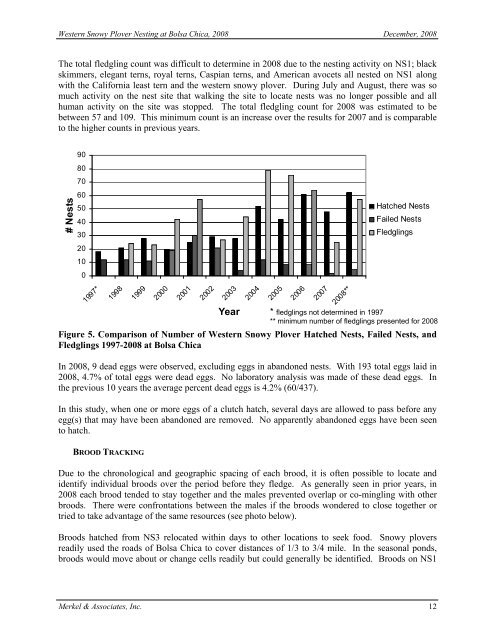2008 Annual Monitoring Report (pdf 10.9MB) - Bolsa Chica ...
2008 Annual Monitoring Report (pdf 10.9MB) - Bolsa Chica ...
2008 Annual Monitoring Report (pdf 10.9MB) - Bolsa Chica ...
You also want an ePaper? Increase the reach of your titles
YUMPU automatically turns print PDFs into web optimized ePapers that Google loves.
Western Snowy Plover Nesting at <strong>Bolsa</strong> <strong>Chica</strong>, <strong>2008</strong> December, <strong>2008</strong><br />
The total fledgling count was difficult to determine in <strong>2008</strong> due to the nesting activity on NS1; black<br />
skimmers, elegant terns, royal terns, Caspian terns, and American avocets all nested on NS1 along<br />
with the California least tern and the western snowy plover. During July and August, there was so<br />
much activity on the nest site that walking the site to locate nests was no longer possible and all<br />
human activity on the site was stopped. The total fledgling count for <strong>2008</strong> was estimated to be<br />
between 57 and 109. This minimum count is an increase over the results for 2007 and is comparable<br />
to the higher counts in previous years.<br />
# Nests<br />
90<br />
80<br />
70<br />
60<br />
50<br />
40<br />
30<br />
20<br />
10<br />
0<br />
Hatched Nests<br />
Failed Nests<br />
Fledglings<br />
1997*<br />
1998<br />
1999<br />
2000<br />
2001<br />
2002<br />
2003<br />
Year<br />
Figure 5. Comparison of Number of Western Snowy Plover Hatched Nests, Failed Nests, and<br />
Fledglings 1997-<strong>2008</strong> at <strong>Bolsa</strong> <strong>Chica</strong><br />
In <strong>2008</strong>, 9 dead eggs were observed, excluding eggs in abandoned nests. With 193 total eggs laid in<br />
<strong>2008</strong>, 4.7% of total eggs were dead eggs. No laboratory analysis was made of these dead eggs. In<br />
the previous 10 years the average percent dead eggs is 4.2% (60/437).<br />
In this study, when one or more eggs of a clutch hatch, several days are allowed to pass before any<br />
egg(s) that may have been abandoned are removed. No apparently abandoned eggs have been seen<br />
to hatch.<br />
2004<br />
2005<br />
2006<br />
2007<br />
<strong>2008</strong>**<br />
* fledglings not determined in 1997<br />
** minimum number of fledglings presented for <strong>2008</strong><br />
BROOD TRACKING<br />
Due to the chronological and geographic spacing of each brood, it is often possible to locate and<br />
identify individual broods over the period before they fledge. As generally seen in prior years, in<br />
<strong>2008</strong> each brood tended to stay together and the males prevented overlap or co-mingling with other<br />
broods. There were confrontations between the males if the broods wondered to close together or<br />
tried to take advantage of the same resources (see photo below).<br />
Broods hatched from NS3 relocated within days to other locations to seek food. Snowy plovers<br />
readily used the roads of <strong>Bolsa</strong> <strong>Chica</strong> to cover distances of 1/3 to 3/4 mile. In the seasonal ponds,<br />
broods would move about or change cells readily but could generally be identified. Broods on NS1<br />
Merkel & Associates, Inc. 12






